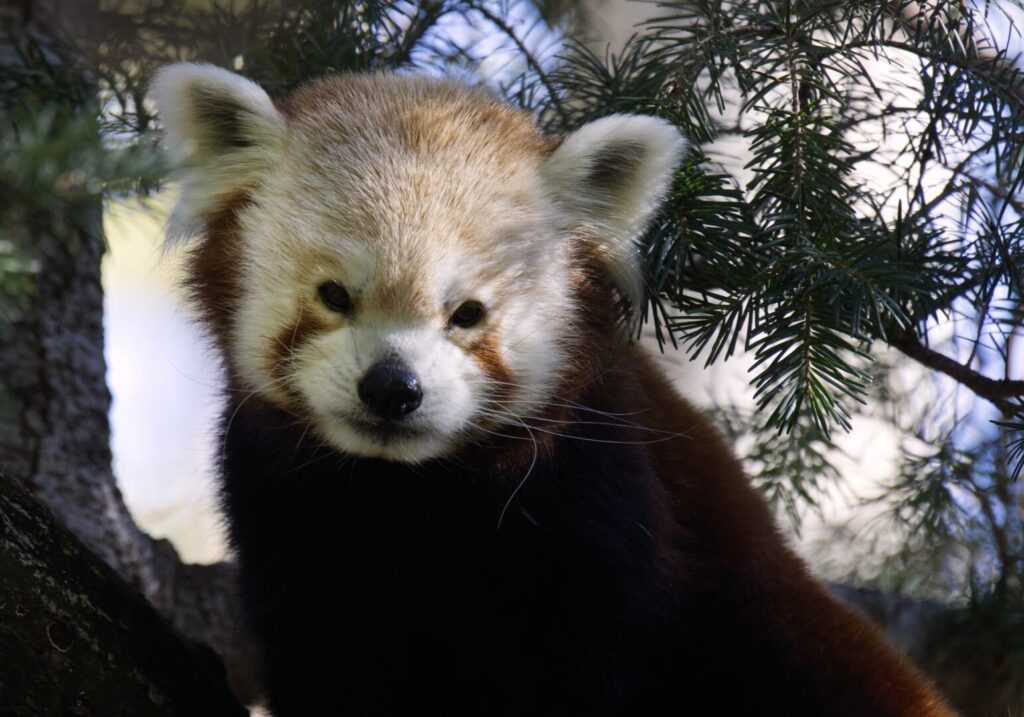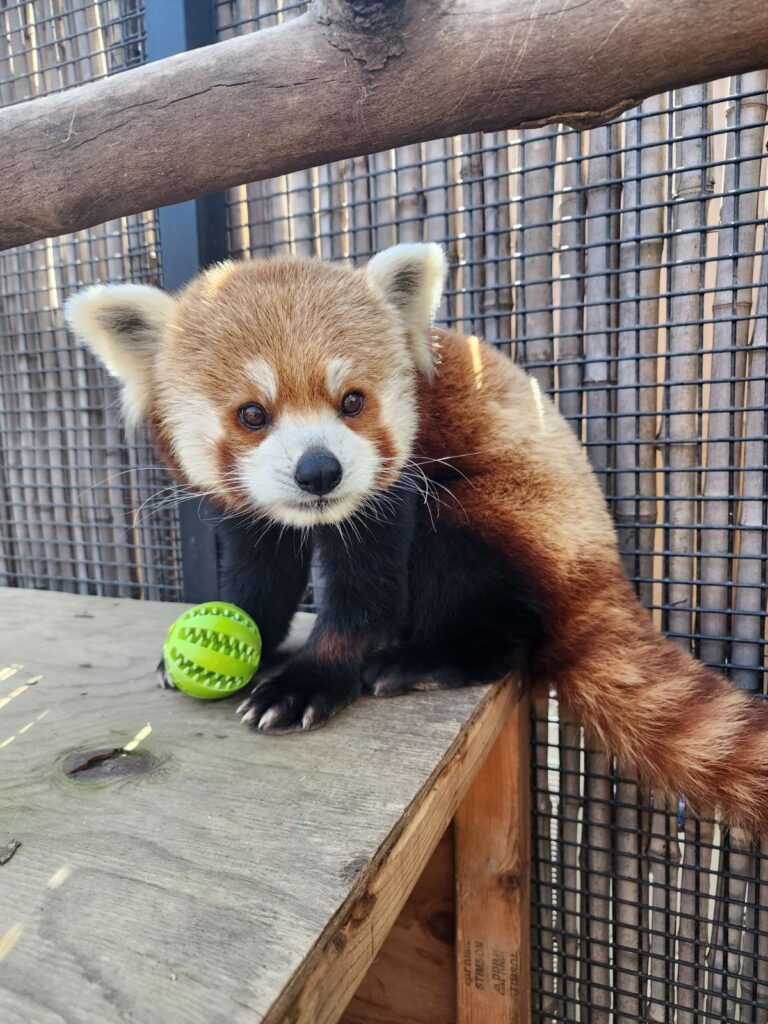Firefox IRL: Meet Amaya, Basu, Takeo and Pili, Sacramento Zoo’s fantastic four red pandas
Did you know that the red panda is also known as a firefox? Sept. 16 is International Red Panda Day, so we thought it would be a good time to visit a Firefox, ahem red panda, in real life and talk to their caretakers at zoos across the U.S. See our full series of interviews here.
Sacramento Zoo has a full house with four red pandas: Amaya, Basu, Takeo and Pili. Just like people, each red panda has a unique personality. Their caretaker, Rachel Winkler, animal care supervisor at the Sacramento Zoo, shares her stories about this foursome.
Originally a math major, Rachel volunteered at the Sacramento Zoo when she discovered how much she liked caring for animals. From there, she went on to other zoos to learn more about becoming a zookeeper. Now, she's back at Sacramento Zoo. She tells about the resident red pandas' favorite snacks, sleeping spots and more.
Tell us about the red pandas you care for....we have four red pandas: one breeding pair (Amaya and Basu) and one pair of roommates (Takeo and Pili). Amaya is 6 years old and is our breeding female. She is pretty shy, only being comfortable with her regular keepers. She loves grapes and bamboo! Basu is 9 years old and is our breeding male. We call him the golden boy" because of his yellow tinted fur, plus he's super sweet. He loves strangers and always comes over when someone new comes to the area. Takeo is 14 years old and is the sweetest old man. Despite not having many teeth left in his old age, he loves craisins (cranberry raisins). He likes to sleep a lot, but usually loses his sleeping spot to Pili, since it's her favorite spot too. Pili is 11 years old and is a sassy lady. She likes to get what she wants, even if that means bumping Takeo out of somewhere he's already asleep. Being on the older side hasn't slowed her down, and she's still very spunky!"
 Sacramento Zoo's 14-year-old Takeo stills still loves to eat craisins despite not having many teeth left. (Photo credit:Sacramento Zoo)What's the coolest part about working with red pandas?
Sacramento Zoo's 14-year-old Takeo stills still loves to eat craisins despite not having many teeth left. (Photo credit:Sacramento Zoo)What's the coolest part about working with red pandas?The best part about working with red pandas is knowing I get to take care of an endangered species; there are less than 10,000 red pandas left in the wild. While it's sad to know their population is struggling in the wild, it is exciting to be privileged to work with such a rare animal, and help raise awareness about conservation efforts to guests to help them in the wild. Here at the Sacramento Zoo, we support the Red Panda Network, who works hard to protect native panda habitat in Nepal as well as conduct research studies to better understand and save the pandas. I also love working with the red pandas because they are charismatic fluff balls who love their grapes."
 Sacramento Zoo's 9-year-old Basu is called the golden boy" because of his yellow tinted fur. (Photo credit:Sacramento Zoo)How did you get your start as a zookeeper?
Sacramento Zoo's 9-year-old Basu is called the golden boy" because of his yellow tinted fur. (Photo credit:Sacramento Zoo)How did you get your start as a zookeeper?I started volunteering at Sacramento Zoo when I was an undergrad at UC Davis. I was actually a math major on track to be a teacher when I realized how much I liked the animal care field and helping with conservation. Through volunteering, I was able to get enough experience to get an internship at the Oakland Zoo over the summer of my junior year of college. After graduation, through my experience at the Oakland Zoo, I applied and was hired as a paid apprentice (full-time temporary learning position) at Oakland. While at Oakland, I got to work with a variety of taxa from tiny tenrecs all the way up to giraffes! After about two years at Oakland, I was able to get a full-time permanent position at the Santa Barbara Zoo, where I worked primarily with gorillas, giraffes and meerkats, as well as being cross-trained in all other mammal areas. After about four years in Santa Barbara, I took a primary ungulate keeper position at Sacramento and moved back. After three years, I was promoted to animal care supervisor, where I oversaw the ungulate department, and recently have moved to oversee the commissary and carnivore department (which includes the red pandas!)."
 Sacramento Zoo's Rachel with red panda Takeo. (Photo credit:Sacramento Zoo)What does your typical day look like?
Sacramento Zoo's Rachel with red panda Takeo. (Photo credit:Sacramento Zoo)What does your typical day look like?Every morning animal care staff has a morning meeting where we go over important tasks for the day, the veterinary schedule for the day and share anything within sections that the whole department should know about. From there, we gather our diets for the day from the commissary and break into the section teams for the day and hash out section goals/needs. Once we have planned out the day, we go and do life checks on the animals to make sure everyone is okay to start our day. Mornings include the majority of cleaning of animal areas and habitats and feeding out a.m. diets. The rest of the day varies based on animals or sections you're in, but some animals get midday feeds as well as p.m. feedings. After lunch usually lends free time for projects like creating enrichment, training or habitat upkeep. At the end of the day, making sure everyone is fed, closed into appropriate areas/given access to off-habitat areas as needed, and we're good to go until tomorrow when we do it all again."
 Sacramento Zoo's 11-year-old Pili is a sassy lady who likes to get what she wants. (Photo credit:Sacramento Zoo)
Sacramento Zoo's 11-year-old Pili is a sassy lady who likes to get what she wants. (Photo credit:Sacramento Zoo)Thank you, Rachel, for sharing your stories about this foursome. Sounds like there are more fun adventures in store for this group.
The post Firefox IRL: Meet Amaya, Basu, Takeo and Pili, Sacramento Zoo's fantastic four red pandas appeared first on The Mozilla Blog.